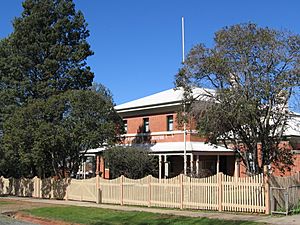Corowa Courthouse facts for kids
Quick facts for kids Corowa Courthouse |
|
|---|---|

Corowa Courthouse, pictured in 2008
|
|
| Location | 8 Church Street, Corowa, Federation Council, New South Wales, Australia |
| Built | 1886–1887 |
| Architect | James Barnet |
| Owner | Department of Justice |
| Official name: Corowa Courthouse; Corowa Court House | |
| Type | State heritage (built) |
| Designated | 22 December 2000 |
| Reference no. | 1450 |
| Type | Courthouse |
| Category | Law Enforcement |
| Builders | W. Squires |
| Lua error in Module:Location_map at line 420: attempt to index field 'wikibase' (a nil value). | |
The Corowa Courthouse is a special old building in Corowa, New South Wales, Australia. It's listed as a heritage site, which means it's important to history and needs to be protected. This courthouse was designed by James Barnet, a famous architect, and was built between 1886 and 1887. It's also known as the Corowa Court House. Today, the Department of Justice owns and looks after it. It became a heritage site on December 22, 2000.
Contents
Corowa's Early Days
In 1838, an explorer named Charles Sturt first explored the Corowa area. Soon after, people started settling there, setting up large farms called "squatting runs." A very important settler was John Foord. He was so impressed by the area in 1839 that he decided to claim a huge piece of land, about 12,000 hectares, right along the Murray River.
Farmers in the area grew wheat and tobacco. In the 1850s, people found gold nearby, including in Corowa itself. This created a big market for the farmers' crops. In 1856, John Foord helped plan a town on the Victorian side of the river, which was named Wahgunyah. He also set up a ferry (punt) there in 1857. This ferry was later replaced in 1863 by a private wooden toll-bridge, also led by John Foord.
The bridge was very important for the growth of the town on the New South Wales side. This area, once called North Wahgunyah, became Corowa. The customs offices at the Corowa bridge handled lots of wool, and the wheat and oats farms produced huge amounts of crops in the late 1800s.
The Courthouse Story
The Corowa Courthouse was designed by James Barnet, who was the main architect for the New South Wales government at the time. It replaced an older courthouse that was built in the 1860s on the same spot. Building the new courthouse started in May 1886 and finished in 1887.
This courthouse became famous in 1893. It was chosen as the place where the Australian Federation League was started. Important meetings were held here with leaders from different Australian colonies. These discussions helped lead to the Federation of Australia, when all the colonies joined together to form one country.
What the Courthouse Looks Like
The Corowa Courthouse is made of red bricks. It has darker red bricks above the windows, forming flat arches. The roofs are sloped (hipped) and made of corrugated iron. At the front, there's a verandah with simple wooden posts. The building looks balanced and the same on both sides (symmetrical). It also has a flat-roofed section added to one side. The doors to the smaller sections on each side have special etched glass panels.
The courthouse was designed during a time when building styles were changing, between the Victorian and Federation periods. It has a classic design, with a taller two-storey middle part and single-storey sections on either side. It uses elements from the Georgian Revival style, like double-hung windows and flat brick arches above them. The front of the central part has a verandah on the ground floor. This verandah is held up by pairs of decorated wooden posts with cast iron decorations.
Building Condition
As of October 2000, the building was in good shape. It had a wooden addition at the back. The original wooden furniture and fittings inside were still there and in good condition.
Why the Courthouse is Special
The Corowa Courthouse is a simple, brick building that looks balanced and nice. It adds a lot to the look of the street. It's also a great example of architecture from the late 1800s, with its Georgian Revival style.
This courthouse is very important for its history and its social meaning. It was the place where important discussions happened between the different Australian colonies before they became one country. For example, the "People's Conference" organized by the Australian Federation League was held here on July 31 and August 1, 1893. Another important meeting of state leaders in 1902, which led to the River Murray Agreement, also took place here.
The Corowa Courthouse was officially listed on the New South Wales State Heritage Register on December 22, 2000.

